#silver ganesh murti
Explore tagged Tumblr posts
Text
Complete Your Rituals with a Silver Puja Thali Set From Code Silver
Enhance your spiritual rituals with our elegant Silver Puja Thali Set from Code Silver to Crafted with precision, this set adds a touch of grace to your puja. Shop now to elevate your ceremonies.

0 notes
Text
Welcome the beautifully silver Ganesh idol God to your home and make your home temple auspicious with our Monica jewelers.
0 notes
Text
#Laxmi Ganesha#God Laxmi Ganesh#Laxmi Ganesha Murti#Ganesh Laxmi In Silver#Silver Laxmi And Ganesh#Laxmi Ganesh Silver Murti#Silver Ganesh Laxmi Murti Price#Silver Ganesh And Lakshmi Price#Laxmi Ganesh Murti In Silver Price#Lord Ganesha And Lakshmi#Laxmi Ganesh Murti Price#Silver Ganesh And Laxmi Murti#Laxmi Ganesh Murti Near Me#Buy Online Laxmi Ganesh
0 notes
Text
✨ Experience Divine Grace with Our Silver Ram Darbar ✨
Today, we proudly present our exquisite Silver Ram Darbar featuring beautifully crafted idols of Ram Ji, Lakshman Ji, Sita Ji, Hanuman Ji, and Bharat Ji. This sacred set embodies purity and devotion, perfect for enhancing your home temple or gifting during auspicious occasions.
Crafted with 92.5% pure silver, this stunning ensemble reflects intricate craftsmanship and deep spiritual significance, bringing blessings of peace, prosperity, and protection into your home.
🛍️ Explore more silver Pooja items at Jewels Box:
Silver Kalash
Silver Ram Mandir
Silver Panchmukhi Diya
Silver Lakshmi & Ganesh Murtis
📍 Visit Us: 9A, Rohtas Pandit House, Shahnajaf Rd, Hazratganj, Lucknow
📞 Inquiries: 7705014055
#JewelsBox #SilverRamDarbar #RamJi #PureSilverItems #PoojaItems #BestSilverShopInLucknow #SilverJewelry #ChandiKaMandir #SilverRamMandir #RamDarbarSet
0 notes
Text
Spiritual Accessories and Devotional Gifts: Embracing Divinity in Everyday Life | Rgyanshop
Spiritual accessories go beyond mere decoration; they serve as tools that help us direct our thoughts and feelings toward the divine. These items can include prayer beads, incense holders, meditation cushions, and detailed religious symbols or deity statues. Each piece carries its own unique energy, capable of transforming a simple area in your home into a peaceful sanctuary. Prayer beads, such as rudraksha malas or tulsi beads, are frequently utilized in meditation and chanting. They assist in keeping track of mantras while helping to maintain focus on the divine. Likewise, incense burners, brass diya (oil lamps), and puja thalis (worship plates) are often employed during prayer rituals to enrich the spiritual ambiance of the environment. For many individuals, wearing spiritual jewelry like pendants, bracelets, or rings adorned with sacred symbols such as Om, Ganesha, or the Trishul allows them to carry their beliefs with them wherever they go. These accessories not only enhance their personal style with a spiritual flair but also act as protective charms, providing a sense of safety and guidance throughout the day.
Giving and receiving Devotional gifts is a lovely tradition that stems from the wish to share blessings, love, and positivity. Whether it's for a housewarming, wedding, birthday, or festive occasion, a devotional gift embodies a sense of divinity that brings joy and tranquility to the recipient. At Rgyanshop, we see these gifts as more than just items; they represent a form of spiritual expression, infused with the energy of love, devotion, and goodwill. For instance, giving a Lakshmi Ganesh idol during Diwali is a common practice that symbolizes a desire for prosperity and success. Likewise, feng shui items like crystal trees or the Laughing Buddha are thought to attract good luck and positive energy into homes. These choices are popular among those who wish to bestow peace, abundance, and protection upon their loved ones. Devotional gifts are also perfect for personal milestones such as marriages or anniversaries. A beautiful set of silver puja items, spiritual books, or jewelry inscribed with mantras can serve as a meaningful and treasured gift, reflecting the giver’s thoughtful consideration for the recipient's well-being.
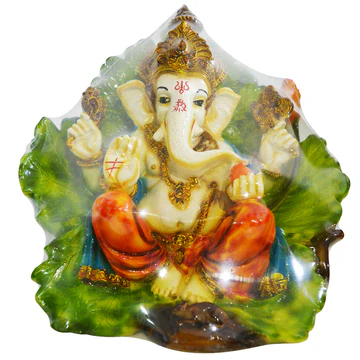
When choosing spiritual accessories or devotional gifts, it's essential to think about the recipient's beliefs and preferences. A gift that resonates with their faith or spiritual journey can foster a stronger bond between the giver and the receiver. For example, for someone who enjoys yoga or meditation, a set of chakra stones or a yoga mat featuring sacred geometry designs might be an ideal choice. For a dedicated follower of a particular deity, presenting a beautifully crafted murti (idol) of that deity, whether it’s Lord Krishna, Shiva, or Durga, can enhance their spiritual practice. Additionally, devotional gifts such as handmade prayer journals, singing bowls, or holy scriptures can encourage deeper reflection and mindfulness in everyday life. These items are perfect for cultivating a meditative atmosphere, whether for personal use or as a considerate gift for someone starting their spiritual journey.
At Rgyanshop, we understand that spirituality is a deeply personal journey, and having the right spiritual accessories and devotional gifts can truly enhance that experience. Our collection features a wide variety of thoughtfully selected products aimed at inspiring devotion, peace, and well-being for you or your loved ones. Whether you're looking to deepen your own spiritual practice or find the ideal gift for someone special, we have something for everyone. From beautifully crafted idols and rudraksha beads to meditation aids and auspicious gifts like brass diyas, feng shui items, and chakra jewelry, each item is chosen for its quality, beauty, and spiritual importance. Embrace divinity and share joy with the spiritual accessories and devotional gifts from Rgyanshop—where tradition beautifully blends with the modern world of spirituality.
0 notes
Text
Lord Ganesha’s Wisdom: The Symbolism of Elephant Motif Jewelry
Description: Elephant motif jewelry pays homage to Ganesha’s wisdom, intellect, and the power to overcome obstacles, infusing these qualities into wearable art.
Introduction:
Lord Ganesha, the elephant-headed Hindu deity, is revered as the Remover of Obstacles and the God of Wisdom and Intellect. His unique representation with an elephant head has deep-rooted symbolism, making him a beloved and worshipped figure in Hindu culture. This symbolism extends to the world of jewelry, where the elephant motif is often featured in various forms. In this article, we will explore the significance of Lord Ganesha’s elephant head and how jewelry adorned with this motif embodies wisdom, intellect, and the power to overcome obstacles.
The Enigma of Lord Ganesha’s Elephant Head

Lord Ganesha’s distinctive appearance is a source of intrigue and wonder for many. To understand the symbolism behind his elephant head, we delve into the rich mythology that surrounds his birth. The story of Lord Ganesha’s creation and his unique head carries profound spiritual lessons.
Ganesha Silver Idols: Bringing Wisdom into Your Home

Ganesha idols made of silver hold a special place in Hindu households. These exquisite pieces of art not only serve as decorative items but also as sources of wisdom and inspiration. We explore the craftsmanship behind silver Ganesha idols and how they bless homes with positivity and success
Ganesh Silver Coins: Wealth and Blessings in One
Silver coins featuring Lord Ganesha’s image are not just monetary tokens but also carriers of divine blessings. We discuss the significance of these coins in various Hindu rituals and ceremonies, particularly during auspicious occasions like Diwali and Ganesh Chaturthi.
Ganesh Puja Thali: Ornate Offerings to the Divine
The puja thali plays a vital role in Hindu rituals and offerings to deities. We delve into the significance of a Ganesh Puja Thali and how it forms an integral part of worship, particularly during Ganesha Chaturthi celebrations. Readers will also learn where to find exquisite online options.
Silver Ganesh Murti: A Prized Possession
Silver Ganesha murtis are not only objects of devotion but also artistic masterpieces. We explore the craftsmanship behind these murtis and their role in spiritual practices, home decor, and as cherished gifts.
Silver Laxmi Ganesh: Blessings of Wealth and Wisdom:
Lord Ganesha is often accompanied by Goddess Lakshmi, the deity of wealth. We delve into the symbolism and significance of the Silver Laxmi Ganesh combination and how it is revered in Hindu culture.
Gold Ganesh Pendant: A Divine Accessory:
Gold Ganesh pendants are not just fashionable but also hold deep spiritual significance. We explore the artistry behind these pendants and how they make for precious, meaningful gifts.
Silver Ganesh: A Timeless Symbol
Silver Ganesh figurines have a timeless appeal. We discuss their versatility as home decor, spiritual items, and collectibles, making them a must-have for enthusiasts.
Silver Lakshmi Ganesh: Celebrating Prosperity:
Lakshmi Ganesh silver coins are symbols of abundance and prosperity. We discuss their role in special occasions and festivals, and how they are considered lucky charms.
Gold Ganpati Pendant: A Symbol of Divine Fortune:
Gold Ganpati pendants are not just fashion statements but also symbols of divine fortune. We delve into their artistic design and the blessings they bring to their wearers.
Conclusion:
The elephant motif, symbolizing Lord Ganesha’s wisdom and the power to overcome obstacles, finds a cherished place in jewelry and religious artifacts. Whether it’s Ganesha idols, silver coins, or jewelry, each item carries a piece of divine significance and an invitation to seek the blessings of the Lord. By adorning these items, individuals can infuse their lives with wisdom, intellect, and the strength to surmount challenges, making them not only beautiful but also spiritually enriching. Visit our Website for more Collections @jpearls.com
0 notes
Text
Unveiling the Divine: 7 Stunning Ganesh Murti Pen Stand Designs to Elevate Your Home Decor
Introduction
Ganesh Murti, revered as the harbinger of auspicious beginnings, holds a significant place in Hindu culture and households worldwide. From the majestic aura of Laxmi Ganesh Murti to the practical elegance of Ganesh Murti pen stands and the exquisite charm of dry fruit boxes, these artifacts embody tradition, artistry, and functionality. Additionally, the convenience of shopping for Home Decor Items Online has revolutionized how we adorn our living spaces.
Importance of Ganesh Murti
Ganesh Murti, often worshipped at the onset of any new venture, symbolizes wisdom, prosperity, and good fortune. The presence of Lord Ganesh is believed to remove obstacles and usher in success, making Ganesh Murti a cherished addition to homes and workplaces alike.

Versatility of Pen Stand Ganesh Murti
Combining utility with spirituality, pen stand Ganesh Murti serves as a unique piece of desk decor. Crafted intricately, these artifacts not only organize stationery but also infuse workspaces with divine energy, fostering creativity and productivity.
Exploring Laxmi Ganesh Murti
Laxmi Ganesh Murti, a divine amalgamation of Goddess Laxmi and Lord Ganesh, epitomizes prosperity and auspiciousness. Placing Laxmi Ganesh Murti in homes or offices is believed to invite wealth, abundance, and harmony into the space, making it a popular choice for both personal and corporate gifting.
Dry Fruit Boxes: A Fusion of Utility and Elegance
Dry fruit boxes adorned with Ganesh Murti motifs are more than just containers; they are exquisite pieces of functional art. These boxes not only preserve the freshness of dry fruits but also add a touch of sophistication to gifting and festive celebrations.
Finding Home Decor Items Online
The advent of online shopping has simplified the process of finding and purchasing home decor items. With just a few clicks, you can explore a vast array of options, compare prices, and effortlessly bring home the perfect accents to complement your decor style.
Ganesh Murti
Ganesh Murti traces its roots back to ancient Hindu scriptures, where Lord Ganesh is revered as the remover of obstacles and the god of intellect and wisdom. The tradition of sculpting Ganesh idols dates back centuries, with each design bearing intricate symbolism and cultural significance.
Ganesh Murti comes in various forms, ranging from traditional clay idols crafted by skilled artisans to contemporary designs made from metals like brass, silver, or gold. Each material carries its own aesthetic appeal and cultural relevance, allowing individuals to choose according to their preferences and budget.
In Hindu culture, Ganesh Murti holds immense significance during festivals like Ganesh Chaturthi, where elaborate processions and rituals are conducted to honor Lord Ganesh. The immersion of Ganesh idols in water bodies symbolizes the cycle of creation and dissolution, reinforcing the transient nature of life.
Pen Stand
Pen stand Ganesh Murti blends artistry with functionality, serving as a symbolic yet practical addition to desks and workspaces. These intricately crafted artifacts not only organize stationery but also inspire creativity and mindfulness, reminding individuals of the divine presence in their daily lives.
Placing a Pen Stand Ganesh Murti in prominent areas like study desks, office cabins, or reception counters enhances the ambiance and promotes a positive work environment. The presence of Lord Ganesh is believed to bestow blessings and guidance, fostering success and prosperity in endeavors.

To preserve the elegance of pen stand Ganesh Murti, regular dusting and occasional cleaning with a soft cloth are recommended. Avoiding exposure to direct sunlight or harsh chemicals ensures that these artifacts retain their luster and charm for years to come.
Laxmi Ganesh Murti
Laxmi Ganesh Murti symbolizes the divine union of Goddess Laxmi, the goddess of wealth, and Lord Ganesh, the remover of obstacles. Placing Laxmi Ganesh Murti in homes or workplaces is believed to invoke blessings of prosperity, abundance, and harmony, fostering a sense of well-being and fulfillment.
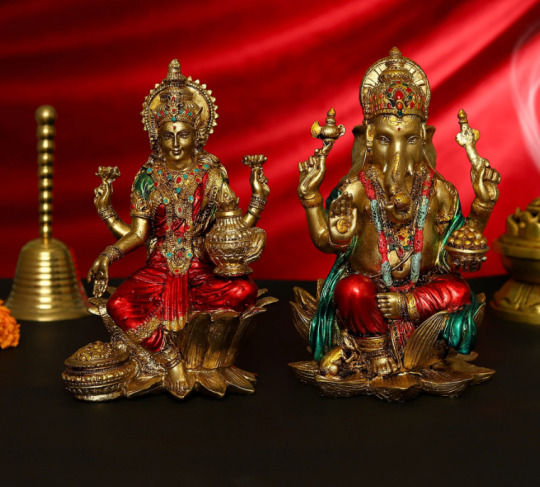
According to Vastu Shastra, placing Laxmi Ganesh Murti in auspicious directions like the north or east corner of the house or office maximizes the flow of positive energy and attracts wealth and prosperity. It is customary to offer prayers and light incense before Laxmi Ganesh Murti to seek blessings for financial stability and success in endeavors.
In addition to its spiritual significance, Laxmi Ganesh Murti serves as a beautiful centerpiece for home decor. Adorned with intricate designs and embellishments, these idols add a touch of elegance and reverence to living spaces, reflecting the devotion and cultural heritage of the inhabitants.
Dry Fruit Box
Dry fruit boxes featuring Ganesh Murti motifs serve a dual purpose of functionality and aesthetics. These intricately designed containers not only preserve the freshness of dry fruits but also serve as exquisite gifts for festive occasions, weddings, or housewarmings.
From traditional wooden boxes with hand-carved Ganesh motifs to contemporary designs embellished with intricate metalwork, Dry Fruit Box come in a myriad of styles and patterns. Each design reflects the rich cultural heritage and craftsmanship, making them coveted pieces of art and utility.
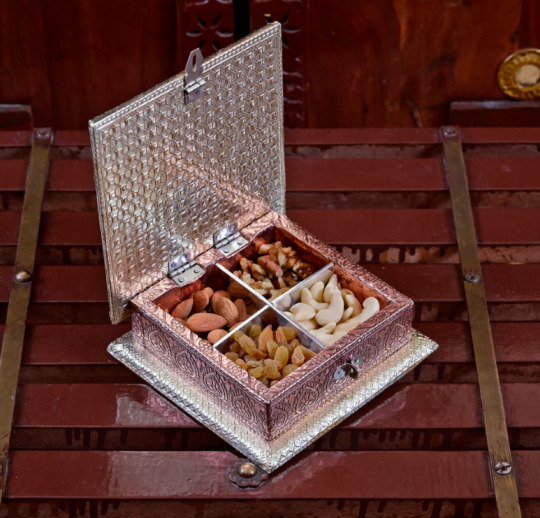
Presenting dry fruits in elegantly crafted boxes adds a touch of sophistication and thoughtfulness to gift-giving. Whether as a token of appreciation or a gesture of goodwill, these boxes adorned with Ganesh Murti designs symbolize blessings of prosperity, happiness, and good health for the recipient.
Home Decor Items Online
The advent of e-commerce has revolutionized the way we shop for home decor items. With online platforms offering a wide range of products, from traditional artifacts to modern accents, shopping for home decor has never been more convenient or accessible.
Online retailers curate an extensive collection of home decor items, catering to diverse tastes and preferences. Whether you're seeking minimalist designs, ethnic motifs, or contemporary pieces, you'll find a plethora of options to suit your aesthetic sensibilities and complement your living space.
While shopping for home decor items online offers convenience, it's essential to ensure the quality and authenticity of the products. Opting for reputed sellers, reading customer reviews, and verifying product specifications can help you make informed decisions and procure genuine artifacts that enhance your home decor.
Conclusion
In conclusion, Ganesh Murti, whether in the form of pen stands, Laxmi Ganesh idols, or embellished dry fruit boxes, embodies tradition, spirituality, and artistic expression. These artifacts not only add beauty and elegance to our living spaces but also serve as reminders of our cultural heritage and values. Whether purchased online or through traditional channels, each piece carries its own significance and stories, enriching our homes with blessings and positivity.
0 notes
Text
0 notes
Text
How to do Lakshmi Pooja at home on this Diwali?

Diwali is an auspicious Indian festival and it is a festival of lights. Before this festival people cleans their houses and decorate their houses with colorful lights, diyas, candles, torans, Diwali lamps and lanterns, torans, and other Diwali items. Also, people celebrate occasions by sending diwali gifts online to those who are not able to visit and those you can visit go to their dear ones’ houses and offer diwali gifts, dry fruits, hampers, and sweets. In the evening, all Indians perform Lakshmi Puja at their houses and workplace. All believe that Goddess Lakshmi is the goddess of wealth, happiness, and prosperity. This lakshmi puja is performed to welcome goddess lakshmi at their house. People pray to goddess Lakshmi and wish for peace, wealth, and prosperity in their family members’ lives. If you want to do Lakshmi Puja/ Diwali at your house and you don’t know the steps on how to do Puja then read this blog, here we will describe step by step how to do Lakshmi Puja at home this Diwali.
This Year Muhurat of Diwali 2021: Time for Lakshmi Pooja and Lord Ganesha Puja
Time: 06:09 pm to 08:20 pm
Date: 4th November 2021
Duration: 1 hour 55 minutes
Pradosh Kaal: 17:34:09 PM to 20:10:27 PM
Vrshabh kaal: 18:10:29 PM to 20:06:20 PM
Lakshmi Puja Vidhi: Step-by-Step guide:
Step 1: Purify your home
The first step of Lakshmi pooja is the Diwali cleaning and it is a very important step. You need to clean every corner of your house. After cleaning, sprinkle Gangajal (holy water from river Ganga) to purify the surroundings.
Step 2: Set up puja platform
In your puja room/living room where you are going to perform lakshmi pooja, there you need to spread a red cotton cloth on a table/stool and keep a handful of grains and Diwali sweets in the center.
Step 3: Place a Kalash
Take the kalash can be of silver/bronze pot. You need to place the kalash in the middle of the grains. And then Fill the kalash with 75% of water and put one supari (betel nut), one marigold flower, a coin, and some rice grains. Place 5 mango leaves on the kalash in a circular design.
Step 4: Place idol of Lakshmi and Ganesha for puja
Now in the puja area, you need to place the idol murti of Goddess Lakshmi in the center and the murti of Lord Ganesha on the right side (South-West direction) of the kalash. Take a small Diwali pooja thali and make a small flat mountain of rice grains, draw a lotus flower with Haldi, put some coins and place it in front of the idol.
Step 5: Place accounts books/wealth related items
Now place your business/accountancy book and other wealth/business-related items in front of the idol.
Step 6: Apply tilak and light diya
Now apply tilak to Goddess Lakshmi and Lord Ganesh and light Diwali diyas. Apply tilak to kalash also.
Step 7: Offer flowers
Now offer flowers to Lord Ganesh and Lakshmi. Keep some flowers in your palm for prayer.
Step 8: Recite Puja Mantra
Place flowers in your palm and join your hands in prayer mode, close your eyes and recite the Diwali puja mantra. After prayer, offer the flower kept in your palm to Ganesha and Lakshmi and offer diwali gifts for family.
Step 9: Offer water
Take a Lakshmi idol murti and bathe it with water followed by panchamrita. Bathe it again with water, wipe with a clean cloth and place it back on the Kalash.
Read more - https://www.indiagift.in/blog/how-to-do-lakshmi-pooja-at-home-on-this-diwali/4503
2 notes
·
View notes
Photo

Shri Bada Ganapati Temple, Indore, Madhya Pradesh Temple Connect wrote: Better known for its size than antiquity, this temple houses very large murti of Ganesh measuring 25 feet from crown to foot. Created as a result of a dream to an Avantika (Ujjain) resident Shri Dadhich, it was built in 1875. The murti has a most interesting configuration of ingredients: bricks, lime stone, masala made of Gud, methi dana, soil collected from seven moksha puris: Ayodhya, Mathura, Maya, Kashi, Kanchi, Avantika, and Dwaraka, mud from stables of horse, elephant and cow, the powder of Pancharatna : heera, panna, moti, manek and pukhraj (diamond, emerald, pearl, ruby and topaz) and the holy water from all major places of pilgrimage. The metalic frame is of gold, silver, copper, brass and iron. (via Facebook: Temple Connect)
65 notes
·
View notes
Text
Ganesh Murti- The Divinity Personified
Lord Ganesh is respected across the world, especially by the Indian community, as the benevolent God who guides our wisdom and bestows success in our life and business. That is why the Indian Hindu families worship him on a daily basis. You can easily find the Lord ganesh murti at their worship rooms, drawing rooms, and workplaces. There are many stories related to this benevolent lord of auspiciousness, prosperity, wisdom, and benevolence. Likewise, there are many stories related to Lord Ganesh that are interesting, educative, and full of moral virtues. That is why many Indian temples generally have at least one ganesh murti.

Worshipping Lord Ganesh during Diwali
During Diwali Lord Ganesh is worshipped along with Goddess Lakshmi- the goddess of wealth and Goddess Saraswati-who is the Goddess of language, creativity, wisdom, learning, purity, and arts. It is believed that worshipping these three divine personalities help people gain wealth, knowledge, and prosperity in their life. That is why Indians not only worship Lord ganesh murti at home during Diwali but also offer them special worship at their workplace to ensure positive growth.
White colored for even better results
It is believed that placing the White-colored Lord ganesh murti at home can bring even more positive results. It translates to more happiness, a higher volume of wealth, and sustainable prosperity among all members of the home. One thing to keep in mind is that the idol’s back should face your home's outside area and not the inner area. Marble is one of the whitest and luxurious materials that can be employed for crafting lifelike white statues of Lord Ganesha. You can easily buy statues online or offline. The excellent artwork, hours of hard work, and attention to the details by expert craftsmen offer a unique look to these statues.

Right direction to place the idol
While Northeast direction is considered the most auspicious part of any house to place ganesh murti, alternatively, you may also place it in either west or east directions. While worshipping the idol you should sit carefully so that you face either of the two directions- east or north.
It is also advised not to place the god’s idol in the south direction as it is not considered to be an ideal place for such statues. Moreover, the walls that run aside your bathroom or toilet shouldn’t at all be used for placing or supporting Lord Ganesha's idol.
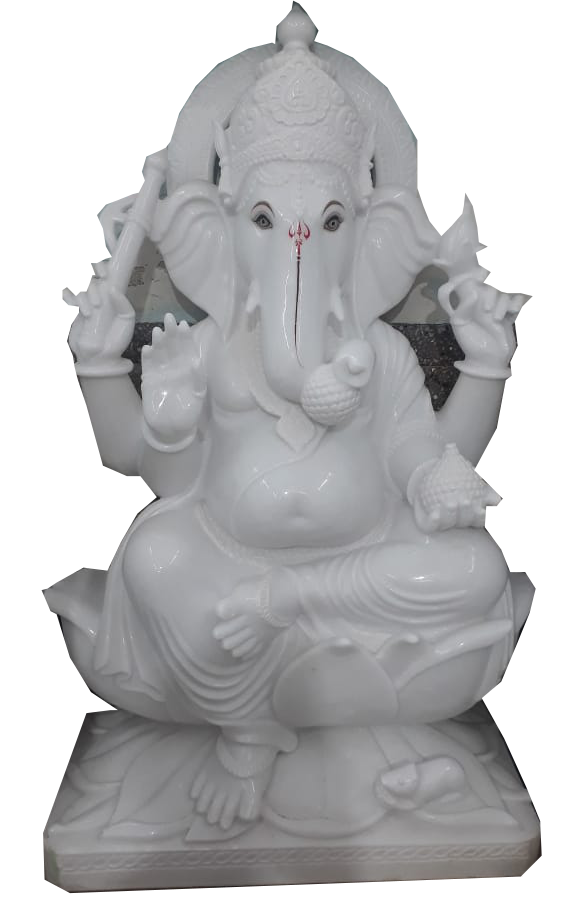
Just like any other idol Lord ganesh murti should not be placed in the bedroom. AT all costs avoid keeping it in your bedroom but even if you must, then you can keep the same in the northeast direction of your bedroom. Moreover, make sure that you should never sleep or sit in such a way that your feet face God’s idol as it is considered disrespectful.
Offer the respect
When placing the Lord Ganesha idol, make sure that you place it respectfully on a platform that is suitably raised above the level of the surrounding area. It is also a good idea to keep a small silver bowl just in front of the Lord and offer daily Naviedya (offering to the Lord)- especially something sweet.
#Ganeshmurti#MarbleMoortiManufacturer#Marblemoortionline#RadhaKrishnamurti#MarbleGaneshStatue#makranamarblemoorti
1 note
·
View note
Text
Silver Ganpati murti is a fine ornament that justifies the beauty of tradition with a spiritual connotation. Ganesh is also known as Vinayaka or lord of new beginning and one would like to have an idol of Ganapati incomplete at his home.
0 notes
Text
#ganesha#ganesha ji#lord ganesha#ganesh ji#shri ganesha#ganesh murti#ganesha god#ganesh idol#ganesh ji ki murti#cute lord ganesha#ganesh idol for car#ganesha statue#silver ganesha idol
0 notes
Text
Sacred Badrinath
Badarinath is one of the holy shrines for Vaishnavites among the 108 divya desams incarnation of Lord Vishnu. Badrinath town is also the part of Panch Badri temples including Yog Dhyan Badri, Bhavishya Badri, Adi Badri and Vriddha Badri, along with Badrinath temple.

About Temple
The main entrance gate of Badarinath temple is colourful and imposing popularly known as Singhdwar. The temple is approximately 50 feet tall with a small cupola on top, covered with a gold gilt roof. The Badarinath temple is divided into three parts (a) The Garbha Griha or the sanctum sanctorum (b) The Darshan Mandap where rituals are conducted and (c) The Sabha Mandap where pilgrims assemble.
At the Badarinath Mandir Gate, directly opposite the main Idol of Lord himself, is seated idol of Bird Garud, vehicle / carrier of Lord Badarinarayan. Garud os seen is sitting position and in prayer with his hands folded. The walls and pillars of the mandapa are covered with intricate carvings.
The Garbha Griha portion has its canopy covered with a sheet of gold and houses Lord Badari Narayan, Kuber (God of wealth), Narad rishi, Udhava, Nar and Narayan. The complex has 15 idols. Especially attractive is the one-metre high image of lord Badarinath, finely sculpted in black stone. According to legend Shankara discovered a black stone image of Lord Badarinarayan made of Saligram stone in the Alaknanda River. He originally enshrined it in a cave near the Tapt Kund hot springs. In the sixteenth century, the King of Garhwal moved the murti to the present loction of the temple. It represents Lord Vishnu seated in a meditative pose called Padmasan.
Darshan Mandap: Lord Badari Narayan is armed with Conch and Chakra in two arms in a lifted posture and two arms rested in Yogic Pose. Badarinarayan is seen under the Badari tree, flanked by Kuber and Garuda, Narad, Narayan and Nar. As you look, standing to the right side of Badarinarayana is Uddhava. To the far right side are Nara and Narayana. Narada Muni is kneeling in front on the right side and is difficult to see. On the left side are Kubera-the god of wealth, and a silver Ganesh. Garuda is kneeling in front, to the left of Badarinarayana.
Sabha Mandap: It is a place in the Temple complex where pilgrims and pilgrims assemble.
History
The name of the Badarinath tirtha originates from local word Badari which is a type of a wild berry. It is said that when Lord Vishnu sat in penance in these mountains, His consort Goddess Laxmi took the form of a berry tree and shaded Him from the harsh sun. It is not only the dwelling place of Lord Vishnu Himself but also home to countless pilgrims, saints and sages, who meditate here in search of enlightenment.
"According to Skand Puran, the idol of Lord Badarinath was recovered by Adiguru Shankaracharya from Narad Kund and was re-enshrined in the 8th century A.D. in this temple."
According to Hindu Tradition, Badarinath often called as Badari Vishal, was re-established by Adi Shri Shankaracharaya to revieve the lost prestige of Hinduism and to unite nation in one bond. It was built in the ages when Buddhism was spreading in the Himalayan range and there was worry that Hinduism was losing it's importance and glory. So the Adi Sankaracharya took it upon himself to bring back the glory of Hinduism and built temples in the Himalayas for the Hindu Gods of Shiva and Vishnu. The Badarinath temple is one such shrine and is richly infused with sacred accounts from numerous ancient Hindu scriptures. Be it the puranic story of the Pandav brothers, along with Draupadi, going past on their last pilgrimage by ascending the slopes of a peak near Badarinath called Swargarohini or the 'Ascent to Heaven' or the visit by Lord Krishna and other great sages, these are just some of the many tales which we associate with this holy tirtha.
The famed Skanda Purana describes more about the place as "There are several sacred shrines in heaven, on earth, and in hell; but there is no shrine like Badarinath."
According to Vamana Purana, the sages Nara and Narayana 'fifth avatar of Lord Vishnu' performed Penances here.
Great sages of yore like Kapila Muni, Gautam, Kashyap have performed penance here, Bhakta Narada attained salvation and Lord Krishna loved this region, medieval religious scholars like Adi Shankaracharya, Ramanujacharya, Sri Madhavacharya, Sri Nityananda have come here for learning and quiet contemplation and so many still continue to do even today.
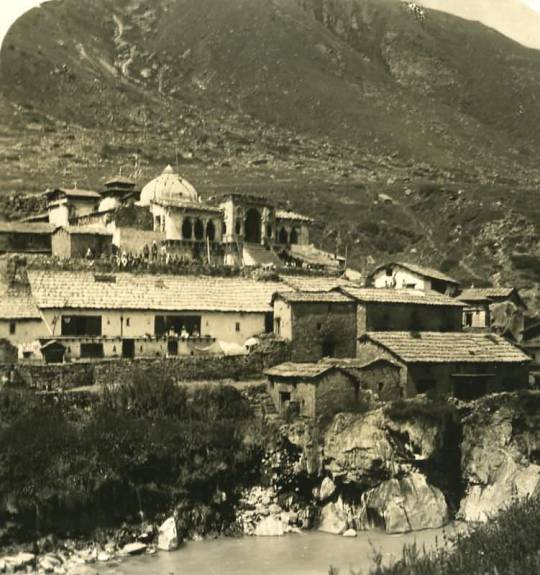
Badrinath Temple near Alaknanda River in 1906

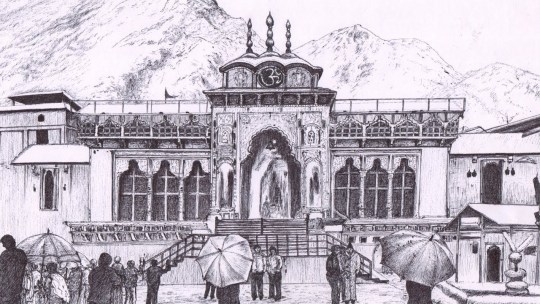



How to Reach ?

Neel Sunder Jalan
6 notes
·
View notes
Text
Ganesh Chaturthi Whatsapp Status in Marathi Hindi English
is one of the most popular 10-day festivities (ISO: Gaṇeśa Chaturthī), otherwise called Vinayaka Chaturthi (Vināyaka Chaturthī), is a Hindu celebration praising the appearance of Lord Ganesh to earth from Kailash Parvat with his mom Goddess Parvati/Gauri. The celebration is set apart with the establishment of Ganesh dirt icons secretly in homes, or freely on expound pandals (brief stages). Perceptions incorporate reciting of Vedic songs and Hindu messages, for example, petitions and brata (fasting).[3] Offerings and prasadam from the day by day supplications, that are conveyed from the pandal to the network, incorporate desserts, for example, modaka as it is accepted to be a most loved of Lord Ganesh.[4][5] The celebration closes on the tenth day after beginning, when the symbol is conveyed in an open parade with music and gathering reciting, at that point drenched in a close by waterway, for example, a stream or ocean. In Mumbai alone, around 150,000 sculptures are submerged annually.[6] Thereafter the mud icon breaks down and Ganesh is accepted to come back to Mount Kailash to Parvati and Shiva.[3][7] The celebration observes Lord Ganesh as the God of New Beginnings and the Remover of Obstacles just as the divine force of insight and intelligence[8][9] and is watched all through India, particularly in the states, for example, Maharashtra, Goa, Karnataka, Madhya Pradesh, Andhra Pradesh, Kerala, Telangana, Odisha, West Bengal, Gujarat and Chhattisgarh,[3][10] and is normally praised secretly at home in Tamil Nadu.[11] Ganesh Chaturthi is likewise seen in Nepal and by the Hindu diaspora somewhere else, for example, in Australia, New Zealand, Canada, Malaysia, Trinidad and Tobago, Guyana, Suriname, different pieces of the Caribbean, Fiji, Mauritius, South Africa,[12] United States, and Europe[7][13][14]
At open settings, alongside the perusing of writings and gathering devouring, athletic and hand to hand fighting rivalries are likewise held.[15]
Substance
1 History
1.1 Ganesh
1.2 Festival
2 Celebration in India
2.1 At unmistakable sanctuaries
2.2 At home
3 Celebration Outside India
4 Foods
5 Environmental effect
6 Gallery
7 See moreover
8 Notes
9 References
9.1 Bibliography
History
Ganesha, Basohli small scale, around 1730.
It is obscure when the celebration began. It turned into a significant social and open occasion with sponsorship of Shivaji after Mughal-Maratha wars. It became mainstream again in the nineteenth century after open intrigue by Indian political dissident Lokmanya Tilak,[16] who advocated it as a way to bypass the pioneer British government restriction on Hindu social affairs through its enemy of open get together enactment in 1892.[17][18][11]
Ganesh
Additional data: Ganesh
In spite of the fact that not insinuating the traditional type of Ganapati,the most punctual notice of Ganapati is found in the Rigveda. It shows up twice in the Rigveda, once in song 2.23.1, just as in psalm 10.112.9.[19][20][21] Both of these songs infer a job of Ganapati as "the soothsayer among the diviners, flourishing incalculable in food directing among the older folks and being the ruler of summon", while the psalm in mandala 10 expresses that without Ganapati "nothing close by or a far distance is performed without thee", as per Michael.[19][22] However, it is questionable that the Vedic expression Ganapati which truly signifies "watchman of the hoards", alluded explicitly to later time Ganesh, nor do the Vedic writings notice Ganesh Chaturthi.[23] shows up in post-Vedic messages, for example, the Grhya Sutras and from that point old Sanskrit messages, for example, the Vajasaneyi Samhita, the Yajnavalkya Smriti and the Mahabharata notice Ganapati as Ganesvaras and Vinayak. Ganesh shows up in the medieval Puranas as "lord of progress, impediment remover". The Skanda Purana, Narada Purana and the Brahma Vaivarta Purana, specifically, bountifully acclaim him.[24] Beyond printed translations, archeological and epigraphical proof propose Ganesh had gotten famous, was adored before the eighth century CE and various pictures of him are detectable to the seventh century or prior.
Ganesh symbol in Khairatabad, Hyderabad, India
For instance, carvings at Hindu, Buddhist, and Jain sanctuaries, for example, at the Ellora Caves, dated between the fifth and eighth century show Ganesh respectfully situated with significant Hindu goddess (Shakti).[25]
Celebration
In spite of the fact that it is obscure when (or how) Ganesh Chaturthi was first observed,[26] the celebration has been openly celebrated in Pune since the time of Shivaji (1630–1680, author of the Maratha Empire).[26] After the beginning of the British Raj, the Ganesh celebration lost state support and turned into a private family festivity in Maharashtra until its recovery by Indian political dissident and social reformer Lokmanya Tilak.[26]
I followed with the best interest swarms who conveyed in parade an interminable number of icons of the god Ganesh. Every little quarter of the town, every family with its followers, every little city intersection I may nearly say, arranges its very own parade, and the most unfortunate might be seen carrying on a basic board their little icon or of papier mâché... A group, pretty much various, goes with the icon, applauding and raises cries of happiness, while a little ensemble by and large goes before the symbol.
– Angelo de Gubernatis, Bombay Gazette (1886)[27][28]
As per others, for example, Kaur, the celebration turned into an open occasion later, in 1892 when Bhausaheb Laxman Javale (otherwise called Bhau Rangari), introduced the first sarvajanik (open) Ganesh icon in Pune.[29] In 1893, the Indian political dissident Lokmanya Tilak adulated the festival of Sarvajanik Ganesh Utsav in his paper, Kesari, and devoted his endeavors to dispatch the yearly local celebration into a huge, efficient open event.[30] Tilak perceived Ganesh's intrigue as "the god for everybody",[31] and as indicated by Robert Brown, he picked Ganesh as the god that overcame "the issue among Brahmins and non-Brahmins", consequently assembling a grassroots solidarity across them to contradict British frontier rule.[32]
Different researchers express that the British Empire, after 1870 out of dread of subversive congregations, had passed a progression of statutes that restricted open gathering for social and political reasons for in excess of 20 individuals in British India, however excluded strict get together for Friday mosque petitions under tension from the Indian Muslim people group. Tilak accepted this successfully hindered the open get together of Hindus whose religion didn't command every day petitions or week by week social affairs, and he utilized this strict exception to make Ganesh Chaturthi to dodge the British pioneer law on huge open assembly.[16][17][11] He was the first to introduce huge open pictures of Ganesh in structures in Bombay Presidency, and other celebratory occasions at the festival.[33][note 1]
God Ganesh: political impediment remover
Is there any good reason why we shouldn't change over the huge strict celebrations
into mass political assemblies?
— Lokmanya Tilak, Kesari, 8 September 1896[38]
As per Richard Cashman, Tilak enrolled and enthusiastically invested in god Ganesh after the 1893 Hindu-Muslim common brutality in Bombay and the Deccan riots, when he felt that the British India government under Lord Harris had more than once favored one side and not treated Hindus decently on the grounds that Hindus were not well organised.[39] In Tilak's gauge, Ganesh love and parades were at that point mainstream in provincial and urban Hindu populaces, across social stations and classes in Baroda, Gwalior, Pune and the vast majority of the Maratha locale in the eighteenth century.[40] In 1893, Tilak extended Ganesh Chaturthi celebration into a mass network occasion and a concealed methods for political activism, scholarly talk, verse presentations, plays, shows, and people dances.[41]
In Goa, Ganesh Chaturthi originates before the Kadamba time. The Goa Inquisition had prohibited Hindu celebrations, and Hindus who didn't change over to Christianity were seriously confined. Be that as it may, Hindu Goans kept on rehearsing their religion in spite of the limitations. Numerous families love Ganesh as patri (leaves utilized for adoring Ganesh or different divine beings), an image is drawn on paper or little silver icons. In certain families Ganesh icons are covered up, an element extraordinary to Ganesh Chaturthi in Goa because of a prohibition on dirt Ganes symbols and celebrations by the Jesuits as a feature of the Inquisition.[42]
Festivities
Man painting a sculpture of Ganesh
Craftsman setting up Ganesh's picture for the celebration in Margao, Goa
The Laalbaaghcha Raja (the most eminent variant of Ganesh in Mumbai) in parade.
Open arrangements for the merriments start a very long time ahead of time. Nearby Mandapa or Pandal's are typically subsidized either from gifts by neighborhood occupants or facilitated by organizations or network associations. The creation of the Murti in Maharashtra for the most part starts with "Padya pooja" or loving the feet of Lord Ganesh. The Murti's are brought to "pandals" on the day or a day prior to the celebration starts. The pandals have expound embellishment and lighting.
At home, the celebration readiness incorporates buys, for example, puja things or adornments a couple of days ahead of time and booking the Ganesh murti as right on time as a month previously (from nearby craftsmans). The murti is brought home either a day prior or upon the arrival of the Ganesh Chaturthi itself. Families enhance a little, clean part of the house with blossoms and other bright things before introducing the icon. At the point when the Murti is introduced, it and its sanctuary are enlivened with blossoms and different materials. Upon the arrival of the celebration, The stately establishment of the earth murti (icon) is done alongside serenades of blessed mantras and pooja including bhajans during a specific favorable time of the day.
In anticipation of the celebration, craftsmans make earth models of Ganesh available to be purchased. The Murti's range in size from 3⁄4 inch (1.9 cm) for homes to more than 70 ft (21 m) for huge network celebrations.[43]
The date for the celebration is normally chosen by the nearness of Chaturthi Thithi. The celebration is held during "Bhadrapada Madyahanaa Purvabaddha". In the event that the Chaturthi Thiti starts around evening time
1 note
·
View note
Text
Lord Ganesha’s Wisdom: The Symbolism of Elephant Motif Jewelry
Introduction:
Lord Ganesha, the elephant-headed Hindu deity, is revered as the Remover of Obstacles and the God of Wisdom and Intellect. His unique representation with an elephant head has deep-rooted symbolism, making him a beloved and worshipped figure in Hindu culture. This symbolism extends to the world of jewelry, where the elephant motif is often featured in various forms. In this article, we will explore the significance of Lord Ganesha’s elephant head and how jewelry adorned with this motif embodies wisdom, intellect, and the power to overcome obstacles.
The Enigma of Lord Ganesha’s Elephant Head
Lord Ganesha’s distinctive appearance is a source of intrigue and wonder for many. To understand the symbolism behind his elephant head, we delve into the rich mythology that surrounds his birth. The story of Lord Ganesha’s creation and his unique head carries profound spiritual lessons.
Ganesha idols made of silver hold a special place in Hindu households. These exquisite pieces of art not only serve as decorative items but also as sources of wisdom and inspiration. We explore the craftsmanship behind silver Ganesha idols and how they bless homes with positivity and success
Ganesh Silver Coins: Wealth and Blessings in One
Silver coins featuring Lord Ganesha’s image are not just monetary tokens but also carriers of divine blessings. We discuss the significance of these coins in various Hindu rituals and ceremonies, particularly during auspicious occasions like Diwali and Ganesh Chaturthi.
Ganesh Puja Thali: Ornate Offerings to the Divine
The puja thali plays a vital role in Hindu rituals and offerings to deities. We delve into the significance of a Ganesh Puja Thali and how it forms an integral part of worship, particularly during Ganesha Chaturthi celebrations. Readers will also learn where to find exquisite online options.
Silver Ganesh Murti: A Prized Possession
Silver Ganesha murtis are not only objects of devotion but also artistic masterpieces. We explore the craftsmanship behind these murtis and their role in spiritual practices, home decor, and as cherished gifts.
Silver Laxmi Ganesh: Blessings of Wealth and Wisdom:
Lord Ganesha is often accompanied by Goddess Lakshmi, the deity of wealth. We delve into the symbolism and significance of the Silver Laxmi Ganesh combination and how it is revered in Hindu culture.
Gold Ganesh Pendant: A Divine Accessory:
Gold Ganesh pendants are not just fashionable but also hold deep spiritual significance. We explore the artistry behind these pendants and how they make for precious, meaningful gifts.
Silver Ganesh: A Timeless Symbol
Silver Ganesh figurines have a timeless appeal. We discuss their versatility as home decor, spiritual items, and collectibles, making them a must-have for enthusiasts.
Silver Lakshmi Ganesh: Celebrating Prosperity:
Lakshmi Ganesh silver coins are symbols of abundance and prosperity. We discuss their role in special occasions and festivals, and how they are considered lucky charms.
Gold Ganpati Pendant: A Symbol of Divine Fortune:
Gold Ganpati pendants are not just fashion statements but also symbols of divine fortune. We delve into their artistic design and the blessings they bring to their wearers.
Conclusion:
The elephant motif, symbolizing Lord Ganesha’s wisdom and the power to overcome obstacles, finds a cherished place in jewelry and religious artifacts. Whether it’s Ganesha idols, silver coins, or jewelry, each item carries a piece of divine significance and an invitation to seek the blessings of the Lord. By adorning these items, individuals can infuse their lives with wisdom, intellect, and the strength to surmount challenges, making them not only beautiful but also spiritually enriching. Visit our Website for more Collections @jpearls.com
0 notes